Hebridean Celtic Festival
"We are in a unique location, and you have to have a pioneering spirit to make it all the way up to the festival if you don't have ties here," says Caroline MacLennan, festival director of the Hebridean Celtic Festival -- Fèis Cheilteach Innse Gall in Scotttish Gaelic. The place she's speaking of is the Isle of Lewis, the northernmost island of the Western Isles, some forty miles off the north west coast of Scotland. For more than twenty years now, the festival has drawn musicians and fans from all across Scotland, and all across the world, who travel by ferry across the Minch to reach Lewis. "We're lucky in a way that the Hebrides have such a huge diaspora -- people are our biggest exports, always have been. Because of that we have now become a focal point for friends and family who now time their homecoming trip around the festival,"MacLennan says.
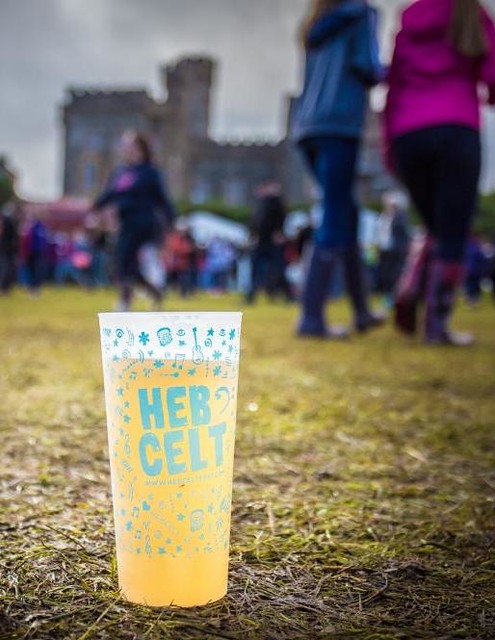

John Sommerville, Box Club
Over the years, HebCeltFest, as it's known for short, has hosted a who's who of Celtic music and related genres of music. La Bottine Souriante and Le Vent du Nord have come from Quebec in Canada, Calum Alex MacMillan from close to home in Lewis itself, and Julie Fowlis from nearby North Uist have offered songs in Gaelic.
Karen Matheson, much awarded and well loved lead singer of the band Capercaillie, has sung in both Gaelic and English; she has family to Barra and grew up in Argyll. Bands including The Box Club, The Proclaimers, Runrig, The Waterboys, and Lau have appeared at the festival. Sharon Shannon has come from Ireland and Ann Savoy has brought her music from Cajun country in Louisiana. The Ploughboys made it from Australia, and Calum Martin's Megantic Outlaw, a song cycle that links the history of Hebrides and Quebec was featured one year. Well loved singers and songwriters from Scotland including Eddi Reader, Donnie Munro, and Karine Polwart have also played HebCelt, as have top instrumentalists and composers, including flute player Michael McGoldrick and fiddler Duncan Chisholm.
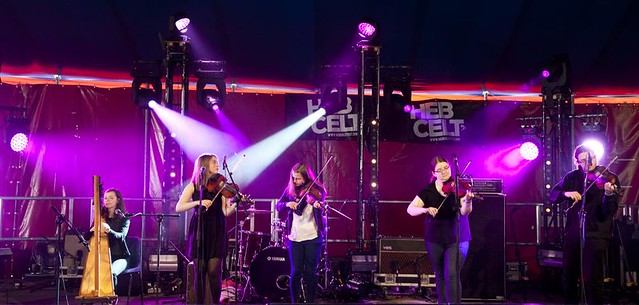
"Our festival promotes Celtic music in its widest sense and we have always drawn on world music influences because of the global links through our diaspora," MacLennan says. "The programming is a healthy mix of popular Celtic music and those perhaps less well known on our shores, along with a sprinkling of the unusual. The festival is proud to support local musicians and we try as much as possible to provide opportunities for them on many levels from those learning their craft to the likes of Julie Fowlis, Mary Smith, Alyth McCormack and the many other fine home bred Gaelic singers and musicians." Scottish Gaelic is widely spoken in daily life in the Outer Hebrides, one of the few places in Scotland where this is still true. If you come the festival, you will certainly hear Gaelic both sung and spoken -- and will have opportunity to take a workshop to learn or brush up your own knowledge of the language.
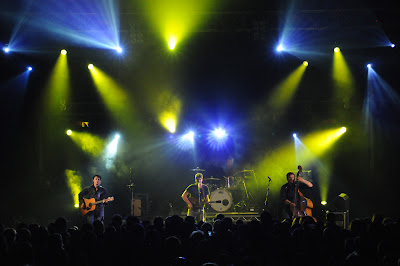
The festival is more than just a casual event for the people who live on Lewis. In addition to the main events in Stornoway, there are concerts and workshops in other areas of the island, and many festival goers explore beyond the festival time, as well. "The festival is a local charity, run by the local community for the community. It's the biggest tourist attraction in the area and because it is a multi-site festival and not a self-contained unit, the local community benefits in many different ways," MacLennan points out. Those who come to HebCeltFest are contributing to the life of the island community. "The festival itself promotes local produce, crafts, and innovation and many providers for the festival are themselves charities," MacLennan says. "For example, one year the local hospice were raising funds to build an extension and ran bus tours during the festival to help with their efforts. By coming to the event and the islands, festival goers are contributing hugely to the ongoing viability of many local businesses and not just those who are tourism related." To put that in a bit of context, in 2016 the festival directly generated 1.4 million pounds in revenue, but additional funds spent with local businesses meant a net economic effect of 2.2 million pounds. The festival received a public subsidy of £120,000, meaning it showed a return of £18 for every £1 of investment from the public sector.

Michael McGoldrick

Mairearad Green of Box Club
Volunteers are a major part of making the festival work, from setting up the stages to helping artists find their way around to tearing things down when it's all done. "The volunteers are like our audience in that they have grown with us and it's now like a big family. They don't all live in the islands, some are from outwith the UK even, but they all make an effort to come home and help out and the festival is the richer for that," MacLennan says. "Our core team has more or less remained the same for some years now, which is hugely helpful in working with the wider volunteer force. Of course there is always a turnover and we welcome new volunteers each year but I personally keep in touch with ex volunteers all over the world, like Australia and Korea."
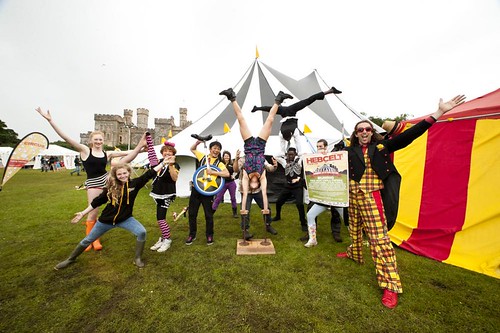
Workshops in Scottish Gaelic, songwriting, and other areas are offered, there's food and drink available, games of the island sport shinty, and there are likely to be sessions at every local venue after hours, and maybe even on the ferry coming and going to the islands. There's an after hours festival club, too. The hearts of the action, though, are at the An Lanntair Cultural Center for more intimate concerts and under the Big Blue Tent on the grounds of Lews Castle for main stage events. The tent, in fact, became an inspiration for Calum Martin to compose a theme song for the festival, a piece called Blue on Green. "We feel it really conveys the excitement and anticipation generated by our festival, inspired by the Big Blue Tent which hosts our main gigs on the Lews Castle green," says MacLennan.
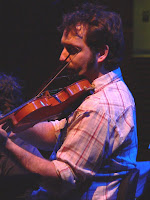
Olivier Demers of Le Vent du Nord
Caroline MacLennan has been with the festival since its beginning. There's a lot of planning, budgeting, and paperwork to be done, but, she says, "on the whole, it's the best job I've ever had." She's happily seen attendance grow. "The other main change since the early days is in the growth of younger festival goers," she says. "Our family friendly pricing strategy has developed this market. We get a huge kick out of seeing the younger festival goers proud to support their festival, which, in turn, promotes traditional music and the unique Hebridean language and culture. You can't ever walk down the streets of Stornoway without bumping into someone sporting our merchandising - and we have used this to develop an area on the website for where you've been with your [festival logo] t-shirt on. Some great places they've been to!"
The Hebridean Celtic Festival, Stornoway, Isle of Lewis, Scotland, happens in mid July every year.
Tickets and other information available on line at www.hebceltfest.com, and the festival is on twitter as well, at @hebcelt
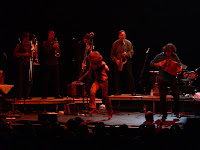
La Bottine Souriante
Kerry Dexter is the Music Editor for Wandering Educators.
Kerry's credits include VH1, CMT, the folk music magazine Dirty Linen, Strings, and The Encyclopedia of Irela nd and the Americas. She also writes about the arts and creative practice at http://www.musicroad.blogspot.com - Music Road. You may reach her at music at wanderingeducators dot com.
HebCelt festival stage photos by Leila Angus @ Brighterstill and Colin Cameron, courtesy of HebCeltFest
Individual artist photos courtesy of and copyright Kerry Dexter
-

- Log in to post comments



















Dr. Jessie Voigts
thanks so much, kerry - this sounds FANTASTIC!! i esp love le vent du nord - have several cds of theirs. thanks for sharing!
Jessie Voigts, PhD
Publisher, wanderingeducators.com
Kerry Dexter
If you live in the UK, BBC Alba will be presenting two programs taped at HecCelt Fest. First time the festival will have been in television this way. check your schedules though July for air daites.
Kerry Dexter
Music Editor, WanderingEducators.com
http://musicroad.blogspot.com/
Dr. Jessie Voigts
kerry - do you know if they'll have it streaming from their radio's website?
Jessie Voigts, PhD
Publisher, wanderingeducators.com
Kerry Dexter
Jessie, as far as I know, not, and I couldn't find anything on radio scotland about it. far as I know, these are two one off hour long programs that are being done by the television folk, to be broadcast in Uk during the next two weekends.
Kerry Dexter
Music Editor, WanderingEducators.com
http://musicroad.blogspot.com/
Kerry Dexter
If you attended this year's event, you may complete the post event evaluation http://www.hebceltfest.com/questionnaire/, which is used to gather data on the event which will be used to continue
to improve the fest. All entries will automatically be entered for a prize draw of weeked tickets to the 2010 fest.
Kerry Dexter
Music Editor, WanderingEducators.com
http://musicroad.blogspot.com/
Suzi Tremmal (not verified)
I love the Isle of Lewis. Didn't get a chance to make to the Festival - did anyone go? Highlights?
Suzi
Kerry Dexter
Suzi,
over at the festival website, they've got some review articles, and I believe Caroline is just now finishing up posting photos from this year's fest. agree, Lewis is great -- I am partial to North Uist as well.
Kerry Dexter
Music Editor, WanderingEducators.com
http://musicroad.blogspot.com/
Kerry Dexter
Heb Celt Fest was named event of the year last night at the Scots Trad Awrds. congratulations!
Kerry Dexter
Music Editor, WanderingEducators.com
http://musicroad.blogspot.com/